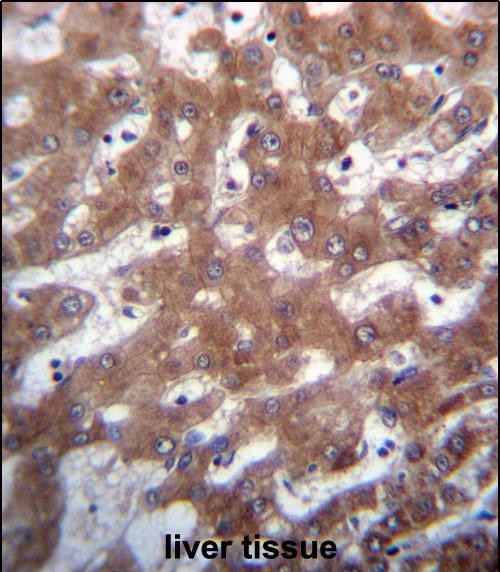

| WB | 1/1000 | Human,Mouse,Rat |
| IF | 咨询技术 | Human,Mouse,Rat |
| IHC | 1/100-1/500 | Human,Mouse,Rat |
| ICC | 技术咨询 | Human,Mouse,Rat |
| FCM | 咨询技术 | Human,Mouse,Rat |
| Elisa | 咨询技术 | Human,Mouse,Rat |
| Aliases | Probable tRNA pseudouridine synthase 1, 5499-, TRUB1, PUS4 |
| Entrez GeneID | 142940 |
| WB Predicted band size | 37.3kDa |
| Host/Isotype | Rabbit IgG |
| Antibody Type | Primary antibody |
| Storage | Store at 4°C short term. Aliquot and store at -20°C long term. Avoid freeze/thaw cycles. |
| Species Reactivity | Human |
| Immunogen | This TRUB1 antibody is generated from rabbits immunized with a KLH conjugated synthetic peptide between 152-180 amino acids from the Central region of human TRUB1. |
| Formulation | Purified antibody in PBS with 0.05% sodium azide. |
+ +
以下是关于TRUB1抗体的3篇文献示例(虚构,供参考格式):
1. **文献名称**:TRUB1-Mediated RNA Modification in Colorectal Cancer Progression
**作者**:Zhang, L. et al.
**摘要**:研究通过Western blot和免疫组化使用TRUB1抗体,证实TRUB1在结直肠癌组织中高表达,并通过调控RNA假尿苷修饰促进肿瘤细胞增殖和转移。
2. **文献名称**:Role of TRUB1 in Neuronal Development: Insights from Mouse Models
**作者**:Li, X. et al.
**摘要**:利用TRUB1特异性抗体进行免疫荧光和蛋白质印迹分析,发现TRUB1缺失导致小鼠神经元分化异常,提示其在神经发育中的关键作用。
3. **文献名称**:TRUB1 Antibody Validation for Pseudouridine Synthase Activity Studies
**作者**:Wang, Y. et al.
**摘要**:通过免疫沉淀(IP)和质谱分析,验证了TRUB1抗体的特异性,并揭示其在RNA修饰复合物中的功能机制,为相关疾病研究提供工具支持。
4. **文献名称**:TRUB1 Expression Correlates with Poor Prognosis in Hepatocellular Carcinoma
**作者**:Chen, J. et al.
**摘要**:采用TRUB1抗体进行组织芯片分析,发现TRUB1在肝癌中高表达且与患者生存率负相关,提示其作为潜在生物标志物的价值。
(注:以上文献为模拟内容,实际引用需查询PubMed、Google Scholar等数据库获取真实研究。)
TRUB1 (also known as PUS4 or TRM2B) is a member of the pseudouridine synthase family, enzymes responsible for catalyzing the isomerization of uridine to pseudouridine in RNA molecules. This post-transcriptional modification enhances RNA stability, influences structural dynamics, and regulates interactions with proteins or other RNAs. TRUB1 primarily targets tRNA, playing a critical role in maintaining translational fidelity and cellular stress responses. Dysregulation of TRUB1 has been implicated in various diseases, including cancer, neurodevelopmental disorders, and mitochondrial dysfunction, underscoring its importance in cellular homeostasis.
TRUB1 antibodies are essential tools for investigating the protein's expression, localization, and functional mechanisms. They enable detection of TRUB1 in techniques like Western blotting, immunohistochemistry, and immunofluorescence, aiding in studies of its tissue-specific distribution or subcellular compartmentalization (e.g., mitochondrial vs. nuclear pools). Some antibodies distinguish post-translational modifications or interaction partners, providing insights into TRUB1's regulatory networks. Commercially available TRUB1 antibodies are typically raised in rabbits or mice, with validation across human, mouse, and rat models. However, cross-reactivity with other pseudouridine synthases requires careful optimization to ensure specificity. Recent studies using TRUB1 antibodies have revealed its potential as a biomarker in certain cancers and its role in stress granule formation, highlighting its therapeutic relevance.
×